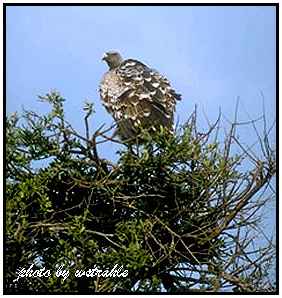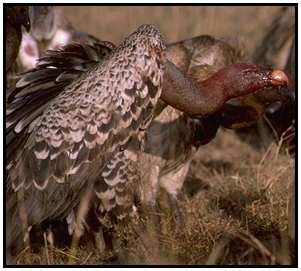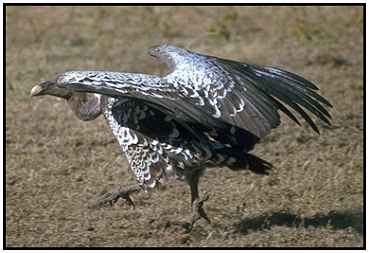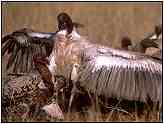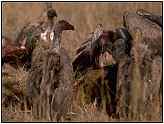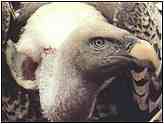RuppellsOrder: Falconiformes. Family: Accipitridae. (Old World vulture). Scientific Name: Gyps rueppellii. Common Names: Rüppell's Griffon Conservation Status: Common. Rescue & Recovery: None. Geographical Range: Wide ranging. From Ethiopia to Sudan; south to Tanzania and across to Guinea. Habitat: The fringes of deserts and dry semi-deserts. Often occurs in high mountain areas and roosts overnight on sheltered, inaccessible rock ledges, or the branches of acacia trees bordering deserts.
Ruppell's Griffon (Photograph Courtesy of Bill Strahle Copyright ©2000)Physical Characteristics: A large vulture with a wing span of 2.6 metres. The head and neck is covered by a thin, rather dirty-white, fluff. At the base of the neck is a white feather collar and the eye colour is yellowish-brown. Overall body colour varies from brown through to black and from a distance the plumage has the appearance of scales or spots. Whitish underbelly and chicken-like feet with sharp talons. Young birds have brown down on the head and neck, along with a darker, more evenly-coloured body. Very sociable, breeding, roosting and gathering in large numbers. When in flight they may cruise at 35 kilometres per hour and travel distances of up to 150 kilometres from a nesting site in the search for food. This is one of the more vocal vultures making loud, harsh calls at a nesting site and a type of squealing when at a carcass.
Ruppell's Griffons (Photograph Courtesy Gerald and Buff Corsi, California Academy of Sciences Copyright ©2000)Food: Rüppell's Griffons begin a search for food two hours after sunrise when the thermals have formed enough to give them needed lift. With their particularly keen eyesight this bird looks for the carcasses of large animals or carnivores in the middle of feeding on prey. They will often wait around for several days until the carnivore moves on leaving them to feast in peace. Unlike some vultures, the Rüppell's Griffon has a particularly strong bill and though it will start feeding on the soft parts of a carcass it soon moves on to eat even the toughest hide and bones. Like some other vultures, the tongue of this bird is covered in backward-facing splines, which assist in cleaning meat from bone. Very occasionally known to kill young antelope and catch snakes, large insects and lizards, but feeds most of the time on carrion. Like many species of vulture these birds gorge themselves at a carcass until they can barely take off.
Ruppell's Griffons (Photograph Courtesy Gerald and Buff Corsi, California Academy of Sciences Copyright ©2000)Reproduction: This bird moves in flocks and nests in colonies of over 100 pairs. It nests among rocks, building nests using sticks and grass which are sealed together using excrement. In some areas nesting is a year round activity, but in Kenya it occurs in May or June, just after the long rainy season. One or two white, pale green or brown spotted eggs are laid and both partners incubate them for about fifty days. The young birds remain in the nest for a further three months and require 800 grams of food per day. Once they take flight they remain within the colony, leaving it only to scour the countryside for food. Other: In November 1973 a Rüppell?s vulture collided with a commercial aircraft, over the Ivory Coast and at an altitude of 37,000 feet. The impact damaged one of the aircraft?s engines, but the plane landed safely. It is unusual for this vulture species to be seen at over 20,000 feet. Thumbnails (Click For Full-Size Image):
|

